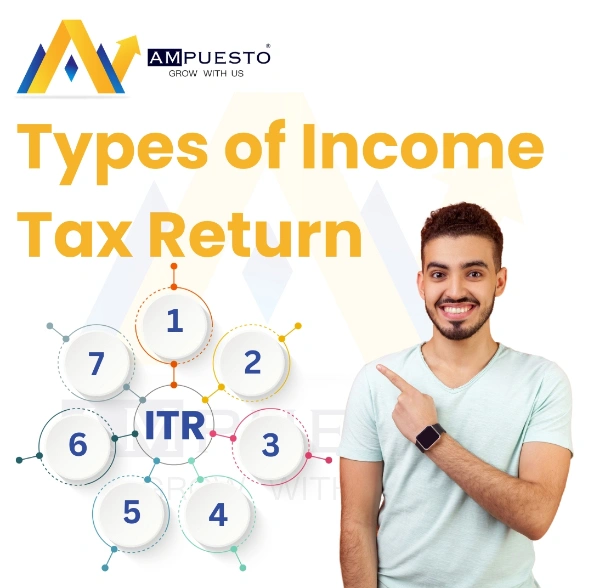Filing Income Tax Returns (ITR) is a crucial responsibility for every taxpayer in India. The Income Tax Department provides various forms to cater to different types of taxpayers, based on their income sources and amounts. Understanding which ITR form to use can be confusing, but it’s essential for accurate filing and avoiding legal complications. Whether you are seeking assistance from a CA, Tax Consultant, or filing by yourself, knowing the basics of each ITR form can help streamline your tax filing process.
ITR-1 (Sahaj)
Who Should Use It?
ITR-1 is for resident individuals with:
- Income from salary or pension
- Income from one house property (excluding cases where loss is brought forward)
- Income from other sources (excluding lottery winnings and income from racehorses)
Key Points:
- Total income should not exceed ₹50 lakh.
- Agricultural income should not exceed ₹5,000.
This form is straightforward and ideal for salaried individuals with simple tax situations. For
accurate filing, consult AMpuesto
ITR-2
Who Should Use It?
ITR-2 is for individuals and Hindu Undivided Families (HUFs) not eligible to file ITR-1, having:
- Income from salary/pension
- Income from more than one house property
- Income from capital gains
- Income from other sources (including lottery winnings and racehorses)
- Foreign assets/income or agricultural income exceeding ₹5,000
Key Points:
- Suitable for individuals with complex tax structures.
- Not applicable for individuals with income from a business or profession.
If your financial situation is complex, it’s advisable to get professional help from a CA near you to ensure precise filing.
ITR-3
Who Should Use It?
ITR-3 is for individuals and HUFs having:
- Income from business or profession
- Income from house property, salary/pension, capital gains, and other sources
Key Points:
- Used by professionals and business owners.
- Comprehensive form capturing all possible income sources.
Given the detailed nature of ITR-3, consulting a CA can help manage the intricacies involved in the filing process.
ITR-4 (Sugam)
Who Should Use It?
ITR-4 is for individuals, HUFs, and firms (other than LLPs) who are residents and have:
- Income from business or profession computed under sections 44AD, 44ADA, and 44AE
- Income from salary/pension
- Income from one house property
- Income from other sources
Key Points:
- Total income should not exceed ₹50 lakh.
- Simplified form for presumptive income under sections 44AD, 44ADA, and 44AE.
This form is designed for small businesses and professionals opting for the presumptive taxation scheme. For guidance, seek a CA who can provide personalized assistance.
ITR-5
Who Should Use It?
ITR-5 is for entities other than individuals, HUFs, companies, and persons filing ITR-7. This includes:
- Firms
- LLPs (Limited Liability Partnerships)
- Association of Persons (AOP)
- Body of Individuals (BOI)
- Trusts and other artificial juridical persons
Key Points:
- Suitable for diverse entities with varying income sources.
- Requires detailed financial disclosures.
Entities with complex tax structures should work closely with a professional, such as a CA for accurate filing.
ITR-6
Who Should Use It?
ITR-6 is for companies other than those claiming exemption under section 11 (income from property held for charitable or religious purposes).
Key Points:
- Mandatory electronic filing.
- Requires detailed financial data and disclosures.
Corporate tax filing can be intricate, making it essential to engage a qualified CA near me for proficient handling.
ITR-7
Who Should Use It?
ITR-7 is for entities including:
- Individuals and companies required to furnish returns under sections 139(4A), 139(4B), 139(4C), or 139(4D)
- Section 139(4A): Income derived from property held for charitable or religious purposes.
- Section 139(4B): Political parties.
- Section 139(4C): Scientific research associations, news agencies, etc.
- Section 139(4D): Colleges, universities, or other educational institutions.
Key Points:
- Suitable for specific entities with detailed reporting requirements.
- Electronic filing is mandatory.
Conclusion
Understanding the correct ITR form for your income sources and financial situation is crucial for compliance and optimal tax management. Whether you are a salaried individual, a business owner, or managing an entity, filing your returns accurately is essential. Consulting a Chartered Accountant (CA) can make the process smoother and ensure that you adhere to all regulatory requirements. For personalized advice and assistance, look for a CA near me, a CA in Delhi, or a CA in Bangalore who can provide expert guidance tailored to your needs.
Remember, timely and accurate ITR filing not only helps avoid penalties but also aids in maintaining a clear financial record, crucial for future financial planning and growth.









